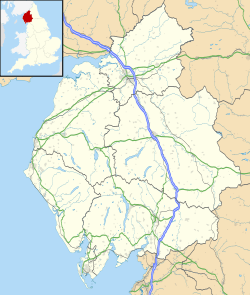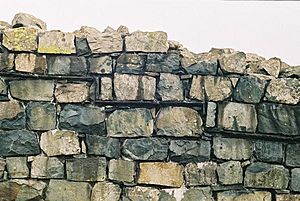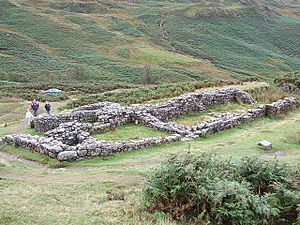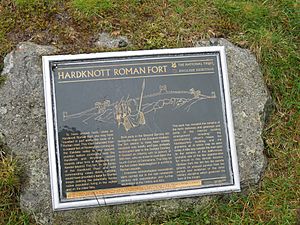Hardknott Roman Fort facts for kids
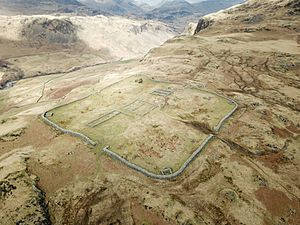
Hardknott Roman Fort; its parade
ground is the flat area at top right |
|
| Location | Cumbria, England |
|---|---|
| Region | Britannia |
| Coordinates | 54°24′10″N 3°12′19″W / 54.40278°N 3.20528°W |
| Type | Castrum |
Hardknott Roman Fort is an ancient Roman army base in Cumbria, England. It is located high up on the western side of the Hardknott Pass. The Romans called this fort Mediobogdum.
The fort was built between the years 120 and 138 AD. It was placed on a rocky hill, giving a great view of the area. A group of 500 soldiers from a place called Dalmatia (which is now Croatia) first lived here. The fort was left empty for about ten years. But then, around 200 AD, soldiers moved back in. It was used for most of the next two centuries.
Contents
Location and Name of the Fort
The fort was built on a rocky spot. This gave the Roman soldiers an amazing view. They could see the River Esk and the whole Eskdale valley. This location helped them protect the important Hardknott Pass.
Hardknott Fort is about 800 feet (244 meters) above sea level. It is not the highest Roman fort in Britain. The highest fort is Whitley Castle, which is about 1,050 feet (320 meters) high.
People today often call the ruins Hardknott Fort or Hardknott Castle. But old Roman maps, like the Ravenna Cosmography, show its real name was Mediobogdum. This fort was on a road between other Roman forts. These included Galava (in Ambleside) and Glannoventa (in Ravenglass).
History of the Fort
The Romans built Hardknott Fort between 120 and 138 AD. It was left empty in the mid-2nd century. This happened when the Roman army moved north into Scotland.
Around 200 AD, the fort was used again. It stayed active until the late 4th century. During this time, a small village grew up outside the fort walls. This village was called a vicus. The first Roman soldiers here were 500 foot soldiers. They were part of a unit called the Cohors IV Delmatarum. They came from the coast of Dalmatia.
What the Fort Looked Like
The fort was shaped like a square with rounded corners. It was 114 meters long on the outside. The walls were about 1.7 meters thick. Ditches around the walls made the whole defense even wider.
The low walls of the fort were rebuilt many years ago. A layer of slate stone shows where the original Roman walls ended. The parts above the slate are modern repairs.
The outer wall had four gates. There was one gate in the middle of each side. There were also lookout towers at each corner of the fort. Inside the walls, you can still see the outlines of several buildings. These included two granaries (for storing grain). There was also the army headquarters building. The commander of the fort had his own house, called a Praetorium. Besides these stone buildings, there were also wooden buildings. These were barracks where the soldiers lived.
Outside the main fort walls, you can find more ruins. There are the remains of a bath house. This bath house had a special round room for sweating, called a sudatorium. There is also a flat parade ground. Many people think this is the best-preserved Roman parade ground in the western part of the Roman Empire.
The parade ground is about 200 yards (183 meters) higher up the hill. It is to the east of the fort. A path led from the fort's East Gate up to the parade ground. A map from 1930 shows the parade ground was as big as the fort itself. It had raised edges to make sure the surface was perfectly flat.
The Fort Today
The land where Hardknott Fort stands is owned by the National Trust. This organization helps protect important places. The fort is looked after by English Heritage.
Archaeological Discoveries
Archaeologists have found leather objects from the Roman time at the fort. In 1965, a piece of leather was found near the granary. Experts think it was part of a soldier's jacket. In 1968, more leather was found. This included several Roman shoes. These discoveries were made by archaeologists Dorothy Charlesworth and J. H. Thornton.
Cultural Connections
- Hardknott is the name of the fort in the book The Fort at River's Bend by Jack Whyte.
- The fort is also mentioned in the poem Spain 1937 by W. H. Auden.
- It appears in a sonnet (a type of poem) by William Wordsworth. He wrote about it as "that lone Camp on Hardknott’s height,/Whose guardians bent the knee to Jove and Mars."
See also
 In Spanish: Hardknott para niños
In Spanish: Hardknott para niños


